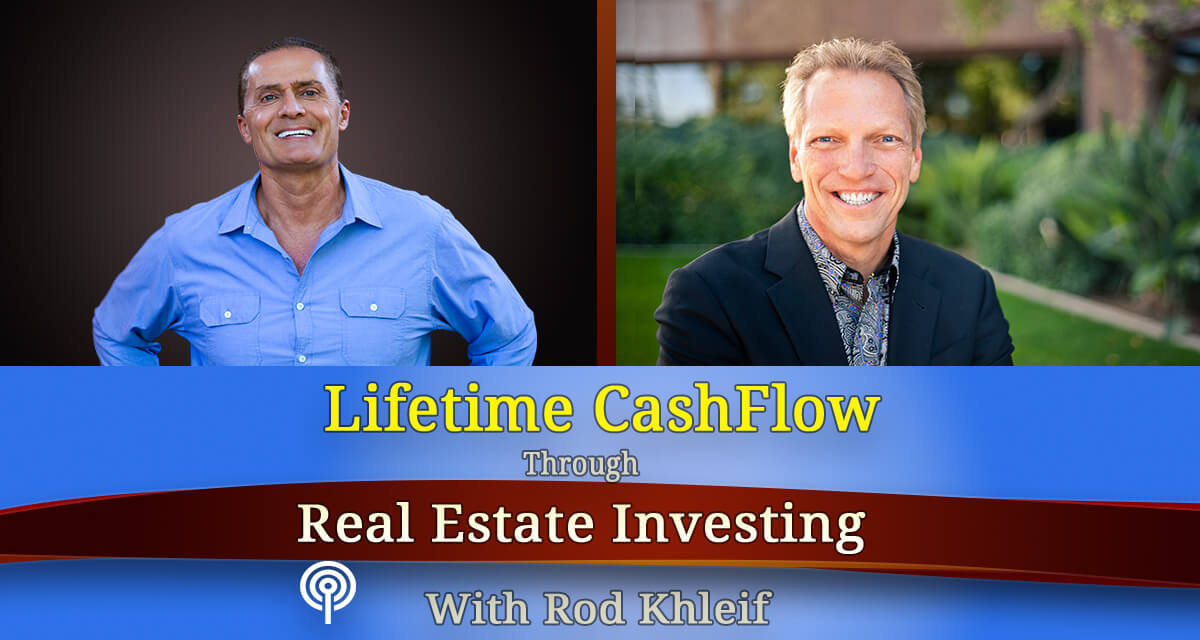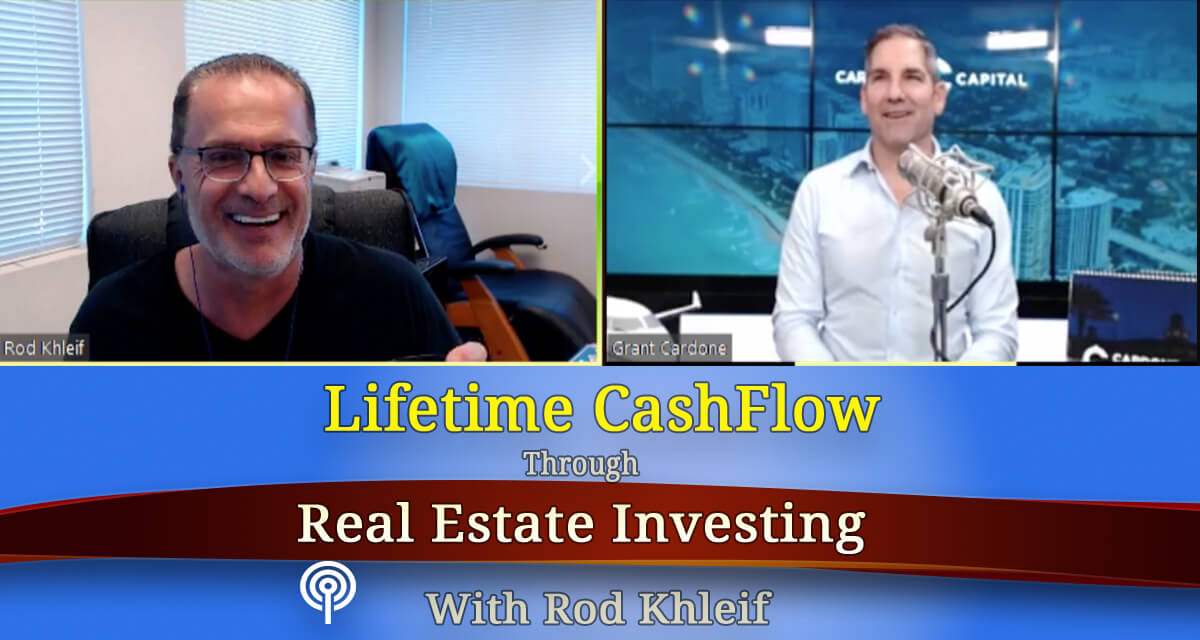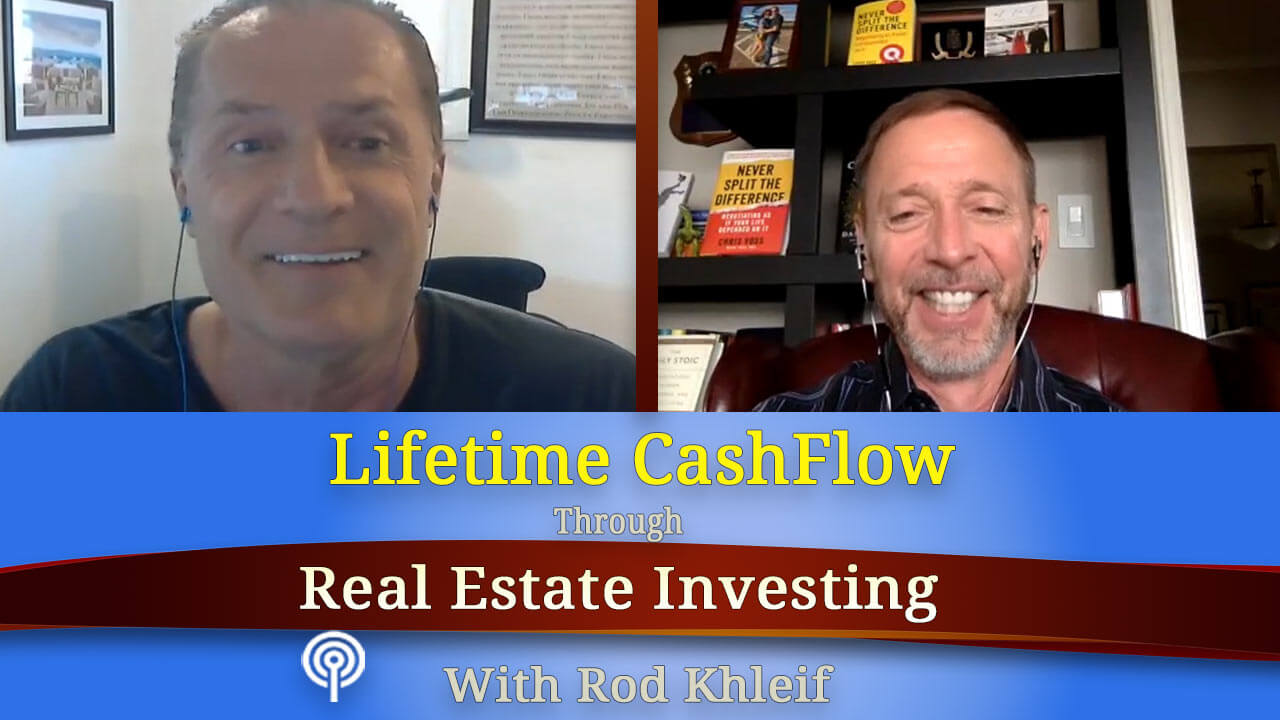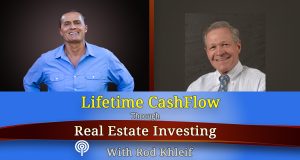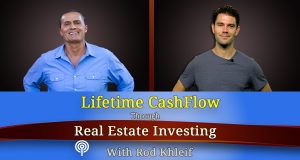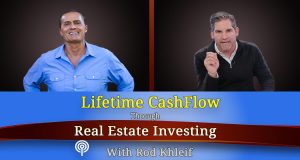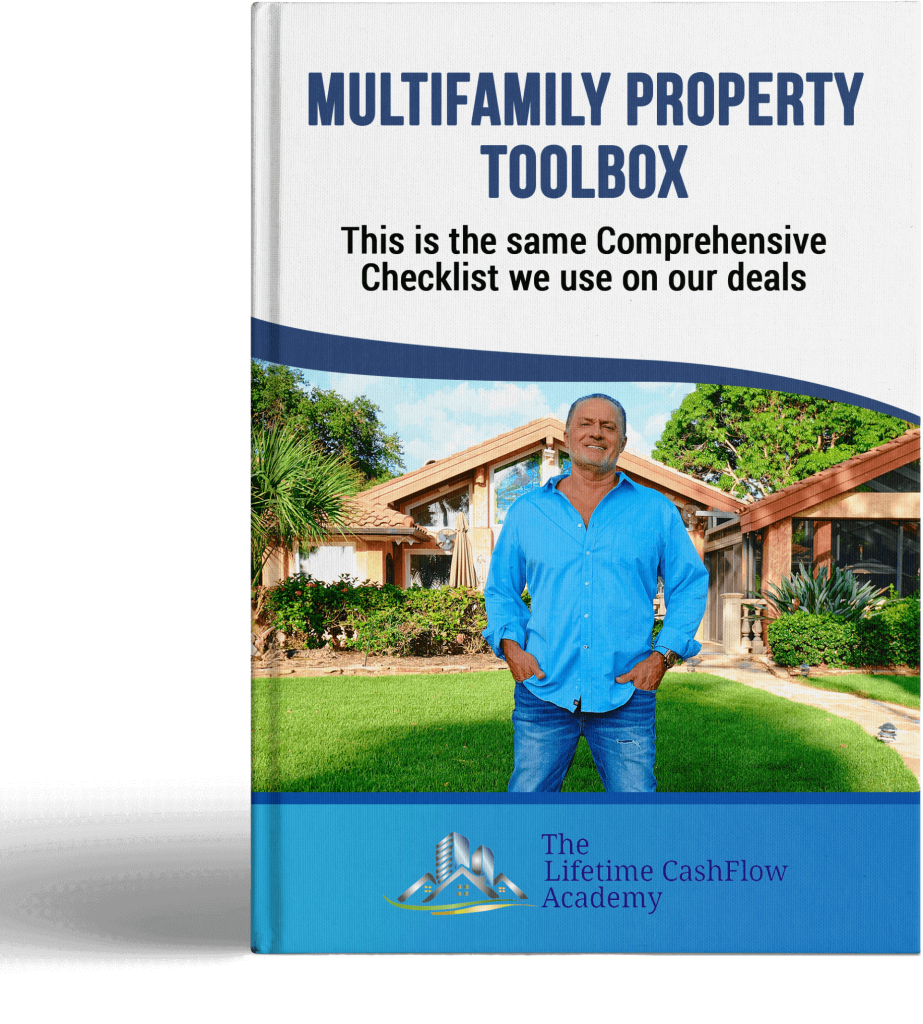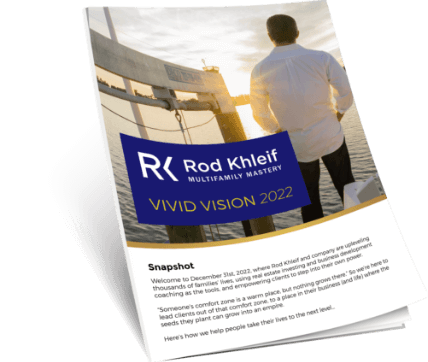Cody E. Payne is the Senior Vice President and team leader for the Office & Industrial Investments Team at Colliers International in Dallas/Fort Worth, Texas. Specializing in representing sellers and advising buyers, Cody brings a wealth of expertise to the Office & Industrial investment property market throughout Texas.
Here’s some of the topics we covered:
- The Industrial Real Estate Space
- The Difference In Debt Between Asset Classes
- Multifamily vs. Industrial Real Estate
- Evaluating Your Potential Asset
- Leasing Industrial Real Estate
To find out more about partnering or investing in a multifamily deal: Text Partner to 72345 or email Partner@RodKhleif.com
Full Transcript Below
Intro
Hi. My name is Rod Khleif, and I’m the host of “The Lifetime Cash Flow Through Real Estate Investing” podcast. And every week, I interview Multifamily Rock Stars and we talk about how they built incredible wealth for themselves and their families through multifamily properties. So hit the “Like” and “Subscribe” buttons to get notified every Monday when a new episode comes out. Let’s get to it.
Rod
Welcome to another edition of How to Build a Lifetime Cash Flow Through Real Estate Investing. I’m Rod Khleif, and I am thrilled you’re here. And we are taking a detour on this interview, in this podcast today because we’re going to talk about a different asset class that I’ve actually never talked about on the show. Okay? And that’s office and industrial. And I’ve got Cody Payne, who is a Senior VP with Colliers in the DFW area, and he’s been in the business forever. And we’re going to talk about why he loves his asset class and let’s have some fun today. Welcome to the show, brother.
Cody
Yeah, hey. No, I appreciate you. Thanks for having me on.
Rod
Sure. So why don’t you give us a little background on you and why you love real estate and then, you know, a little better bio than I did. I’ve got a big long one here, but I figured you could do a better job of introducing yourself than me. So yeah, if you do that and then we’ll go from there.
Cody
Yeah. No, I appreciate it. Yeah, so, obviously, what me and my team specialize in is selling office and industrial buildings. You know, I started my career leasing for many, many years, and then we just kind of converted to, you know, full-time investment sales. And that’s what we’ve done for a long time. And, you know, like I was telling you, kind of beforehand, we work with a lot of cross-asset buyers, especially when, you know, markets get a little shifty like it is now, that look into our product type. And so the Flex Office Industrial warehouse, you know, is very, very popular right now.
Rod
So, you know, and as we talked about, we wanted to come up with how we could add the most value to my listener base. And so we’ll just project your asset class as an alternative. So talk about why you love it and maybe give a little more description of the sorts of assets that you deal with. I know, maybe Flex Office, you know, size, so on and so forth, but let’s start with that and then let’s talk about how you finance those deals.
Cody
Yeah, no, absolutely. And so obviously, there are several sectors of this product type, and so one that I probably really want to hone in on a lot is the small bay, what we call Flex Industrial, where it’s, you know, an industrial business park, but made up of smaller tenants that range anywhere from 1,000 to 5,000 to 10, 000 sqft. And I think the reason that we get such an influx of buyers from the multifamily side on that is because it can be ran very similar to an industrial–or I’m sorry, to a multifamily complex. And in many cases, a lot of them have their property managers manage these buildings as well. And so, I think there’s a lot of uniqueness to it. You know the asset class continues to grow, continues to expand, especially in Dallas, Fort Worth, still building a lot, a lot of buyer-seller activity, a lot of institutions have even gotten into the smaller stuff, obviously in portfolio size. And then on the lending side–
Rod
Hold on, hold on. Before you go there, hold on. So what you’re talking about basically is you’re talking about, you know, some buildings, maybe one building, but lots of– not lots, but multiple tenants, 1,000 to 3,000 sqft. They’ve got a warehouse in the back, they’ve got an office in the front. Maybe they’re a contractor or a manufacturer or whatever. And you’re buying the building and leasing these individual units. Is that the description?
Cody
Absolutely.
Rod
Okay.
Cody
And you’re absolutely right. I mean, your tenants can be anywhere from you know, landscapers, pool companies, electricians, and plumbers.
Rod
Right.
Cody
And so, you know, anytime you’ve got, you know, building going online out here, homes, multifamily, hotels, retails, anytime you have that, you’ve got a lot of these guys. And the smaller tenants, you know one thing to keep in mind, you know, anybody that owns office buildings or anything of that nature knows that the smaller the size, the higher velocity of tenants. And so, you’ve got a much larger pool when you stay in that one to 5,000 sqft. When you start going larger, over that, your tenant pool starts to shrink. And so anytime you have a vacancy, your time on the market can be a little bit longer, and your [inaudible] and finish out can be a little bit more costly. And so, that’s why I prefer the small-based, just like you said.
Rod
Yeah, I’ve seen those where they were condos where people can buy their own space. So you’ve got that and then you’ve got, you know, just like, I guess like residential, residential condos and apartments. You’ve got kind of the same dynamic where somebody rents instead of buys. So, now, let’s talk about, you know, I mean, obviously, in the multifamily space you can do a joint venture, you can syndicate. I’m assuming it’s the same in your asset class. Yes?
Cody
Absolutely. And also just depend on that condo thing that you said.
Rod
Okay.
Cody
We’ve had a lot of people– it’s not as huge out here in Texas, but in other states it is. And so we’ve had a lot of people actually buy Flex Industrial Parks out there–
Rod
Convert.
Cody
And condo them and sell them off individually.
Rod
Yeah.
Cody
And they’ve made huge profit margins on that.
Rod
Okay, interesting.
Cody
[inaudible]
Rod
Yeah, no, no, I mean, certainly, and we’ve gone through those same– obviously those same cycles in the multifamily space as well where people take a nice complex and turn it into condos. So talk about, you know, what is different about debt as it relates to your asset class if anything.
Cody
So in many cases on our side, it’s very rare that you see bridge debt put on stuff.
Rod
Okay.
Cody
We do see it, but not near as much. And I know that that’s very prominent on the multifamily side. On our side–
Rod
Let me add something to that. Okay. I think there’s going to be a lot of pain over that bridge debt from these last few years in what’s coming. I really believe that. You know, I think, you know, these guys are doing the bridge debt to get the higher loan to value when Fanny and Freddie were at 60%, they were at 60% for a reason. You know, I think there’s going to be some pain. But anyway, as an aside, so no bridge debt, what do you have?
Cody
And I agree with you on that. So, yeah, it’s generally, what you’ll see is conventional debt, and so, where it’s, you know, 70/30, 60/40. An interest right now that we just got for somebody was 5.4 on a ten-year, 25-year, and five-year fixed.
Rod
So it’s bank debt when you say conventional or is it–
Cody
Correct.
Rod
Okay, so it’s not like Fanny or Freddy or conforming debt like we have in the multifamily space.
Cody
Correct. I don’t believe you can get Fanny or Freddie debt on Flex Industrial.
Rod
Yeah, forgive me, I don’t– yeah, I guess it would have to be residential related because that’s their framework. And again, like I told you before we started, I’ve never done industrial or office, so I’m completely novice.
Cody
No, it’s alright. In your main debt components out here are going to be, you know, traditional bank debt like you’re saying conventional. Some people get CMBS debt and then life insurance as well. And life insurance is the one that people go to for non-recourse.
Rod
For large ones. Okay. So that’s the only non-recourse option is life insurance in your asset class?
Cody
You can get life insurance on through other smaller companies out here.
Rod
Okay.
Cody
They’re going to be a very high loan-to-value ratio and your interest rate is probably going to be about 100 basis points higher.
Rod
Okay.
Cody
So that’s one thing to keep in mind. But on a lot of this stuff, we really have a pushback on guarantees and doing traditional, conventional.
Rod
Okay. Yeah. I mean, so, you know, primarily, you’re going to be recourse on this debt. And guys, those who are listening, that are brand new in recourse and non-recourse debt, if they foreclose, all they get is the asset. Okay? They come after the asset. With full recourse debt, they can come after you if it sells for less than what the debt is at the foreclosure sale. And I always like to say, ask me how I know. You don’t know this, Cody, I got my ass handed to me in 2008, ’09, I lost $50 million and I had recourse debt. But anyway, historically, what has the default climate been like on your asset class?
Cody
So I would say you saw that more in the office sector, on the traditional office buildings more than the flex and industrial because you know, I went through the 2008, ’09 the crash, like you said, and we saw that more on the office sector. We didn’t even really see a whole lot of it out here in Texas as much as a lot of other states saw, but it was really, really rare to see it on the industrial side. I couldn’t even tell you I think we had one that came back from Lehman Brothers in 2010.
Rod
That makes sense actually, to me. That actually makes sense. Okay. And so, you syndicated just like you would in a multifamily asset. That’s really no different. You raise money that way. You know, do you find a different type of investor likes your asset versus maybe a multifamily syndication or, you know, is it the same?
Cody
No. I mean, so you’ve got your traditional flex office warehouse, industrial investors that always invest in it. We get people from the retail sector and the hotel sector. Like I was telling you before, I mean, I think over the past three years we’ve had more multifamily funds, trust, you know, private people come from the multifamily sector than in the entire 14 years combined of my career. And so, and I think it’s because of that ease of management, you know, the ability to continuously push rent because you got to keep in mind when you look at a lot of these, they’re going to be on one, two-year leases.
Rod
Oh, really?
Cody
Oh yeah. When you’re talking on the small base side.
Rod
Okay.
Cody
So the ability to increase rent is definitely there. And so we’ve seen people push them, and I’ll talk on a per square foot number, but we’ve seen people push rents anywhere from five, six, $7 per square foot gross, you know, up to $12 triple net, 14 triple net in some areas. And so a lot of people have done very, very well. And rents, even I can tell you today, continue to rise and do well. And vacancies and time on the market are very low.
Rod
Okay. So, when you are looking for a flex office, which– let’s just stay there. So when you’re looking for that type of– or flex industrial, whatever you call it, you know, where it’s an office and a warehouse. What are some of the factors– I mean, to me, it’s probably common sense, but what are some of the factors that you look for? I assume you want to be near a highway, centrally located. I mean, it doesn’t matter that you have visibility because that’s usually pretty irrelevant, but maybe not. You tell me. What do you want to look for if you’re evaluating this particular asset?
Cody
And obviously, that’s a great question. Obviously, location on anything is going to be key. However, you won’t see a lot of these with, you know, highway frontage and things of that nature. You’ll see that more on the big box side. I think the biggest thing to look for on these is as little office finish out as possible.
Rod
Okay.
Cody
Where each tenant has a roll-up door, preferably obviously grade level. If there’s a dock high on the back, that’s perfect. And then if you don’t find any with a fenced-in storage yard or side storage or anything of that nature, that’s always a plus, always huge. And that will obviously drive your rents up as well. But really just having that, having access to it is really going to be your main driver. You know, there are lots of–
Rod
When you said roll-up door in the back, I mean, you said grade level. So not level with the back of the truck but just whatever the ground is a ground level, so they can drive their vehicles in?
Cody
Correct. So any time you’re dealing with, you know, 1,000 to 5,000 sqft, it’s going to be very rare that they’re going to have 18-wheelers pulling up.
Rod
Got you. That makes a lot of sense.
Cody
That’s a dock high. And so, a lot of these guys have the grade level because they can drive trailers in, they can drive trucks in.
Rod
Got it.
Cody
They can pull equipment in and out much easier. And, you know, obviously, if you have a dock high then you’re going to be dealing with 18-wheelers coming in a lot more. And that’s, you know, obviously–
Rod
That makes sense. You know, I wouldn’t have thought of that, but that makes complete sense. Now, when you’re– is there a ceiling height that’s the most desirable? Is there a garage height that’s most– the door height that’s most desirable?
Cody
So obviously, with ceiling heights, I’ll always tell you the higher the better.
Rod
The higher the better. Right.
Cody
So we’ll see any of these as low as 12ft high up to, you know, 20 some on ft high. And so, I think your median range is going to be around 16 to 18.
Rod
Okay.
Cody
And that’s ideal.
Rod
Okay.
Cody
You know, but yeah, always on that side, the higher the better.
Rod
Okay. And is there any sort of a due diligence period when you put one of these under contract? Or does money typically just go hard immediately? I’m sure it has these last few years. But, I mean, is that softening up like it is in the multifamily space where we actually are able to kick the tires again, or what’s it like in the industrial, in your world?
Cody
Well, I will tell you in the office flex industrial world, you know, over the past few years we have gotten hard earnest money. It’s a little more rare than I would say on the multifamily side. It is still there. I think your traditional timeline is going to be a 30-day inspection, and a 30-day close, which I believe is very similar to that.
Rod
Right.
Cody
But it’s still competitive, I’ll tell you that. And there are a lot of reasons because of all the people coming from other asset classes. But also you’ve got funds, you know, smaller funds that continue to try to build portfolios and acquire more and more because they’re able to sell these two larger institutions that wouldn’t have looked at this product type ten years ago.
Rod
Interesting.
Cody
And so, that’s another reason why it continues to get more and more competitive.
Rod
Almost like a little roll-up component where someone is buying a few of these in a particular submarket and then going to a larger fund to sell them?
Cody
Correct. At a more compressed cap rate. And that’s still going on. I mean, that’s very, very popular. And so it’s happening all over Texas and so we’ve done stuff literally, you know, from Corpus Christi up to North Texas and there’s a lot of different people that are doing that. More people come into it every day.
Rod
Okay. Let me ask you this. Like in multifamily, is there an argument to build to rent versus buy existing?
Cody
So what I would always say, you know, obviously, if you’ve never built it before, it may not be the best thing to go in and build it immediately unless you’ve got a little bit of experience or align yourself with the right person that can kind of assist on that. I’ll tell you, your build cost is going to be very high right now.
Rod
Right.
Cody
And so, I think that’s very obvious, especially if you’re going to try to do a tilt wall construction or something of that nature. It can be very, very costly. So I would recommend purchasing if you want to build. Obviously, we help people do that. And there are many ways of doing that. You know, it’s just you are dealing with traditionally supply chain issues on electrical and steel components, which are what these buildings are made of.
Rod
That makes sense. Okay, that makes sense. Okay, let’s see, build, and then when you’re leasing these, what’s the strategy there? Are there brokers that specialize in this particular asset class just to lease them or do you just market them? What’s that look like?
Cody
Well, and that’s a good question too. And so, you’re absolutely right. I mean, there are brokers you can hire to do this. A lot of people that I find are successful as they get their manager, someone in-house to do it. Because you got to keep in mind when you’re leasing 1,000, 1,500, 2,000 sqft there’s not a lot of money in a–
Rod
Right.
Cody
For one of those leasing agents unless you have a lot for them to do.
Rod
Yeah.
Cody
And also they’re so easy to lease. You know, we know several people that have literally been building stuff up in North Fort Worth and they put an ad on Craigslist and lease the entire project just off of that or Facebook Marketplace ad before it was even finished construction. And so, as far as the leaseability goes, their leaseability is very, very good.
Rod
That makes sense.
Cody
And so, I don’t always think it’s necessary to [inaudible] for an agent on that.
Rod
Okay. Yeah. Now, guys, if you’re going to go out there and try to build one of these things, don’t do it without somebody that’s already done it, for God’s sake. You always bring somebody in to do your first deal like that, that’s done it before. You don’t have to get married to them. You date, you know, see if you like working with them. But, you know, this like multifamily is the team sport as it relates to that. Let’s see, we talked about marketing. We talked about buying versus building. We talked about financing them. I think we covered the gamut here. What are some pitfalls?
Cody
So that’s a good question. I mean, obviously, your pitfalls are going to be, you know, understanding the area. So, like take this for example. If you’re looking into say, the West Texas market, you got to understand, okay, West Texas, what do we all know that operates on, the oil and gas sector. And so if that economy gets it, it can affect some of those businesses more so than others. So if you’re looking at one of those, you want to look at one that doesn’t have as much oil and gas tenants in there. And so, it’s one thing to understand what businesses operate in what sectors of Texas. And so, that’s why I always say, you know, anytime somebody even calls us and is looking at something in another part of Texas, we’ll reach out to someone out there. Unless, you know, obviously, we’re familiar with it and figure out, all right, what are the businesses that are driving this economy out here? We want to make sure we have a good mix of that. Almost like you don’t want to have a, you know, single tenant industrial building because your risk could be if the tenant leaves and you’re completely vacant.
Rod
Yeah. That makes sense.
Cody
In mitigating the risk on that, I think, is what you really want to look for.
Rod
I’m assuming you would look at the area vacancy rate in this sector, and see what that is. When you’re evaluating a specific asset, I’m assuming you’re really looking at the tenants’ strengths? And how would you know that? How would you know what their financial viability is? Do you do like estoppels or how do you that?
Cody
So, yeah, you’re right. So we traditionally do– anytime we sell something, we do estoppels. That’s not going to tell you their financial strength.
Rod
No. No.
Cody
The only way you really know that is if you either run their credit or get tenant financials as they’re moving in because it’s going to be the rarest of rare that those are able to be passed on from buyer– or from the seller to buyer.
Rod
Right. Okay.
Cody
And I will tell you, a lot of these, you’re not going to see crazy high-grade credits. A lot of them will be local, regional guys. But typically, if you keep the finish out to a minimal, which like I said, you know, we love the–
Rod
Why is that? You said that why do you want to keep the finish minimal?
Cody
Because if you start expanding, you know, if you lease to a tenant and your space right now has one office and a restroom and they want several more offices. Right? So now your construction costs with inflation stay going to continue to, you know, increase that. And then whenever they leave, the next person is probably not going to want that same exact space. So now you’re having to demo that and bring it back to a one [inaudible].
Rod
That makes sense.
Cody
So we typically advise people, look, just offer this, and if a tenant wants something else, it’s their job to pay for it. Or in some cases, it’s best not to do the deal.
Rod
Got you.
Cody
Because we’ve seen some of these where people have gotten spaces back and there’s a lot of office finish out in there. It’s the next thing you know, you’re spending $10,000 just to demo it back to one room and a restroom.
Rod
Yes. Okay. No, that makes complete sense. Okay. And so when you’re doing your evaluation of one of these assets, you’ll get a list of tenants, you’ll check it out, you know, you’ll get a rent roll, and you’ll know whether or not, you know, they’ve been current on the rent and if they’ve been late if you’re getting honest information, so, you know, until you actually release those units, you know, you really can’t dig into the financial viability of each one of those individual tenants like you could. Well, never mind that last part of that comment, but you just have to trust your gut a little bit there. I guess what I’m saying.
Cody
Yeah, no. And I agree.
Rod
Yeah.
Cody
A lot of people do credit apps or get business financials before they come in and lease the space, and so I think it’s pretty similar on that aspect of the multifamily side is the [inaudible]
Rod
Now, you said there’s more churn in that size. Do you know, I mean, historically, what the average tenancy looks like? Average timeline tenancy looks like in one of these, or is there an average?
Cody
They’re going to range.
Rod
Okay.
Cody
I mean, we’ve got some buildings where people have been there for ten, 15, 20 years. You got some that, you know, kind of rotate. And so, your traditional lease time that people are signing right now is going to be anywhere from one to three years, and that’s going to be dependent on you or whoever the owner is on their game plan for increasing rents. And so, like I said, a lot of these are severely under-marketed rents right now, so if you want that flexibility to continue to increase, a lot of people stick people to one-year leases, but your typical timeline is going to be one to three years.
Rod
Got you.
Cody
With annual rent escalations, obviously, already built into the lease.
Rod
Right. Right. Okay. Anything else that you’re looking for if you come across one of these assets that I haven’t asked you about besides–
Cody
Yes, so you want to look at the current rents in the building. You want to look at the current rents in the market, and if you’re under market, you want to look at what that property has. Maybe they’ve got fenced-in storage, maybe they’ve got larger yards for tenants to park vehicles. And so really, understanding your competition just like a multifamily complex and amenities, as you all call it, it’s virtually the same thing on this. And so, any time you go into understanding your rents that you’re going in at where you think they can go and exactly how to get there, your expenses on these are going to be relatively low.
Rod
Right.
Cody
So managing those is generally pretty easy because, you know, everybody is separately metered and things of that nature, but just kind of having your basis going in, and a good kind of path and game plan on. All right, we’re here. We’re at this rental rate. We want to get here, and this is exactly how we get there. Those are easy to do, and so, it’s just aligning yourself with the right person to get there.
Rod
Okay. So, Cody Payne with Colliers in Dallas Fort Worth. You’ve got a team, I think of what, nine people on your team. And you guide people through this process. Yes?
Cody
That’s all we do on a daily basis.
Rod
Okay, then you must love it. Well, listen, I appreciate you coming to the show, my friend. This has been really eye-opening for me, and, you know, I need to expand my horizons as much as anybody else does. So I appreciate you coming on and sharing your wisdom with my peeps here.
Cody
Absolutely. And we’ll make sure you see some of the stuff we’re working on.
Rod
All right, sounds good. Put me on the list. All right, buddy. Take care. Thanks.
Cody
Thanks, Rod.






